Great Horned Owl at Caldwell Woods/Bunker Hill Oxbow area
March 23, 2006, 645pmNorth Oxbow field rim at Caldwell Woods/Bunker Hill area, Chicago, IllinoisLynne wanted to go for a short run tonight, I wanted to get outside after sitting at my desk all day, we decided to head up to the Bunker Hill Forest Preserve area north of Devon off of Caldwell Avenue. Lynne could get a short run, I could take the kids and see if the Oxbow area would yeild an American Woodcock or two for me displaying.
First rule of birding with kids, don't expect too much. Second rule of birding with kids, be ready for anything. It was my daughter Anna Grace who was looking toward the east while I was looking to the south with my glasses that yelled "Here comes a funny bird daddy." I whipped around, and saw what I would guess was an American Woodcock, or closely related species, as it was flying just above tree level from Caldwell Avenue toward the Chicago River. Now I have never seen a woodcock before, so I can't count this as a positive ID, but it was the funniest, silliest looking, stubby-tailed, fat long round-bodied, squat-winged flying bird, with a large bill, that I had ever seen. Hopefully it was an American Woodcock, and I will find some in this area later this spring.
Of course, had I been without kids I would have gone the third of a mile to the river to flush this bird out if I could, but I was with a 3 year old and a 9 month old in a stroller, and going across the open field with this stroller was not in my plans.
So we kept puttering about on the upper edge of the Oxbow area of this woods, listening intently for what we could hear, we heard a Northern Cardinal in the distatnce, an American Robin enthusiastically calling for a mate or marking its territory, and we heard what I thought was a Common Nighthawk call, but after getting back to my laptop and checking out the Birds of North America (BNA) website, I decided it was not a Common Nighthawk call, but probably some type of frog instead.
We also found about a dozen Mallard Ducks, and saw more doing flyovers when Anna Grace spotted her mom running up the path to meet us. Lynne took over watching the kids, and I made one last dash down into the Oxbow area to find some American Woodcocks. All of a sudden, out of the corner of my eye, I saw the large open wings of a raptor moving in from the north to a tall tree on the edge of the field area I was in. As it was the end of dusk, this probably wasn't one of the area Red-tailed Hawks, this was an owl.
Its wings were much broader than a hawk's, and as it settled into a perch at the top of the largest tree on the rim of the field, I could see it's round face and distinctive ears, it had to be a Great Horned Owl. It was. I watched it for 5 or more minutes, and then went back up out of this floodplain field to see if I could find Lynne and Anna Grace quickly enough so they could see this wonder too. I did, and Lynne, who loves owls, was especially appreciative. Anna Grace thought it was so "small." I couldn't quite get her to understand that it was just that it was far away and that we didn't want to get any closer and scare it away. Concept not understood. She saw it, and talked about it all night, probably only because that was what Lynne and I talked about the whole car ride home, and if that is what it takes for her to begin appreciating these wonders, so be it.
Once I pointed it out to them, and we moved a bit closer, we watched for another 10 minutes, and then as silently as it arrived, it spread its wings and very swiftly swooped down from his perch into the field, where it was now almost pitch black, and disappeared from our vision. I don't think I have ever been this close to a flying Great Horned Owl, and it was the first owl I found on my own in the wild, or should I say it found me. Well, anyway, I wasn't following somebody else's directions to find this owl. This one was all ours. Thrilling. And what a wingspan! All just three plus miles from our home.
No "new" birds (don't feel I can count the flyover of the woodcock-like bird), but if you can't appreciate this kind of birding thrill, then you shouldn't be counting species in the first place.
Only 10 birds, total, and a near fall into the river at Bunker Hill Forest Preserve
Bunker Hill Forest Preserve, Chicago, Illinois
North of Devon, west of Caldwell on Chicago's NW side
Sunday, March 5th, 2006, 1030am-12pm
After yesterday's great day in the field in Lake and McHenry Counties, I thought I would take about 2 hours I had in the late morning to check out a familar Chicago running area and see what it might hold for my new birding interest. Unlike yesterday, today it was cloudy, cold with a humid chill in the air. Snow was in the forecast. I thought this might lead to good bird activity ahead of the snow. Instead, I must have missed my window and had a very quiet birding morning.
I parked right inside the Bunker Hill area off of Caldwell, and decided to head south toward the Bunker Hill open area and then swing along the river to see what I could see. Not much.
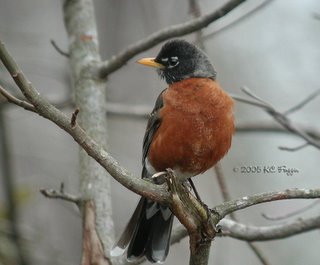 An American Robin (photo KC Foggin) was right at the path as I entered the area, but then I didn't see or hear anything in the Bunker Hill prairie area. The most interesting find were the bones, skull and hide of a long dead white-tailed deer. I had heard a woodpecker or two, but they sounded like they were on the river side of the path. I meandered that way.Quickly, I discovered a Hairy Woodpecker male, and right after that a Red-bellied Woodpecker male. Then, as I was looking up for yet a third woodpecker, I slipped on leaves atop a mud patch and found myself dangling over the river perched precariously on my butt and hands on a 5 foot high river bank. It took 15 minutes of carefully negotiating the slippery bank to keep from falling into cold and swiftly moving the river. My gloves or jeans were terribly mud covered after this little birding mishap.
An American Robin (photo KC Foggin) was right at the path as I entered the area, but then I didn't see or hear anything in the Bunker Hill prairie area. The most interesting find were the bones, skull and hide of a long dead white-tailed deer. I had heard a woodpecker or two, but they sounded like they were on the river side of the path. I meandered that way.Quickly, I discovered a Hairy Woodpecker male, and right after that a Red-bellied Woodpecker male. Then, as I was looking up for yet a third woodpecker, I slipped on leaves atop a mud patch and found myself dangling over the river perched precariously on my butt and hands on a 5 foot high river bank. It took 15 minutes of carefully negotiating the slippery bank to keep from falling into cold and swiftly moving the river. My gloves or jeans were terribly mud covered after this little birding mishap.
I walked along the river to Devon, and under the bridge were the expected Mallard Ducks, 5 of them, two females and three males. I walked from here back across the path to the Bunker Hill prairie area and forested area to the east of there, and on the way I found a dead raccoon skull and skeleton. Didn't realize how sharp their teeth really were.
were.
By now the snow was coming down gently, and the place was terribly quiet. You could hear the snow landing. A Northern Cardinal (photo Richard Fray), a female Dark-eyed Junco (photo KC Foggin) and nothing else. As I got back to the river and woods near were the car was parked, I swear I heard a hoot of an owl, and I heard it again. But it was almost noon and 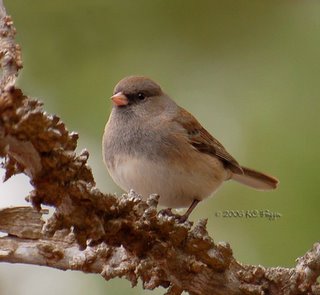 we promised to take Anna Grace to see Curious George at Webster Place, and it was simply time for me to head home. Reluctantly, I did.
we promised to take Anna Grace to see Curious George at Webster Place, and it was simply time for me to head home. Reluctantly, I did.
Quiet day, 10 total birds, 6 species and nothing new. Sure hope for a better birding trip the next time I head to Bunker Hill, I hear it can be great for birding.
Glacial Park & Volo Bog finds us Sandhills, Northern Harriers, Northern PIntails, but no Northern Shrikes!
Glacial Park, Wonderlake, IllinoisNorth of Harts Road, east of 31
Volo Bog, Lakemoor, Illinois
South of Brandenberg Road, west of US12
Saturday, March 3rd, 2006, 815am-3pm
Friday night it was Boy's Poker Night at my friend John's place in Prairie Crossing. It would be the typical cards, beer and really good single malt scotch. There would be no driving the 47 miles home at 1am. Darn, I guess I would just have to stay overnight, and as long as I was that far north, I guess I should just do some birding at Glacial Park and Volo Bog, first thing in the morning, right?
Lynne was fine with this plan, so I shot an email to fellow IBET birder Matt Fletcher who I met last Sunday at North Point Marina, which is part of the Illinois Beach State Park. I love Matt's bird photos, and he seemed like a guy who I could learn from in the field. He lives near Volo Bog and he was willing to take a rookie like myself into the field near his home turf.
It was a bright sunny morning, and before I even left Prairie Crossing I had seen a Downy Woodpecker, Mourning Doves, Red-bellied Woodpecker, Dark-eyed Juncos, and House Finches in John's backyard. On the way out of Prairie Crossing I had to stop at Lake Leopold in Prairie Crossing, where I saw the usual Canada Geese, Mallards, Herring Gulls, Ring-billed Gulls and one 2nd winter Thayer's Gull, the first Thayer's Gull I had ever spotted on my own and the first 2nd winter juvenile I had ever seen. 10 species before I had gone a mile. I was confident I would find the Northern Shrike I had targeted for the day.

On the drive to Glacial Park I spotted a large Red-tailed Hawk on the side of the road having breakfast. I had to pull over and watch for a few minutes. Of course that made me late, and then I got lost in Glacial Park, which may have bummed out Matt, but getting lost there allowed me to find a new bird for my life list, a male RING-NECKED PHEASANT (photo Matt Fletcher). I never knew how fast they could run. By the time I jumped out of the car to get a better look, it was 40 feet away and moving fast. But you can't mistake Ring-necked Pheasants for much else with his red face, green neck and head, white colar and that tail. He was bird #87 for the year, and #69 for Illinois.
I finally met Matt at the main parking lot at 820am, and he had already spotted an interesting looking white bird mixed in with the Canada Geese and Mallards on the marsh pond. As we were walking down to the marsh for a closer look at this mystery bird, Matt casually mentioned that he saw three SANDHILL CRANES (photo Matt Fletcher) on the far side of the marsh. Whoa, wait, stop right there Matt, WHERE? Sure, I had seen these birds before many times, including a day in November of 2004 at Jasper-Pulaski Wildlife Area in Indiana where we saw an estimated 11,000 Sandhills during one sunset. But that was before I was a birder, and I had to see these first. They became life birds #88 and Illinois bird #70.
We got down to the marsh, and just couldn't figure out what the white necked bird with the dark head was. Before we could, either us, or one of the many raptors in the area sent the lot of the geese and ducks flying to the northwest. We would not ID that bird for now. We decided to walk through an oak savanna on the north of the marsh and then over toward the kames on the east of the Nippersink River, I was keen on seeing that Northern Shrike.

On the way to the kames we saw numerous Red-winged Blackbirds. At the kames we saw at least one (juvenile?) Northern Harrier, who disappeared as quickly as we saw him. From the kames we walked north across the marshy area around the Nippersink to a bridge near the campground at the north of Glacial Park. On the way we had Tree Sparrows, Red-tailed Hawks, Sandhills, with one doing a short mating dance for us (photo Matt Fletcher). At the campground

we heard some more sparrows that we never found, and were startled by BLUE JAY (photo Matt Fletcher) that instead of its harsh shrill call, actually whistled a sharp song that neither of us had remembered hearing before. Though I had seen many Blue Jays before being a birder, this was a new bird for this new avocation, and it was bird #89 for the year, #71 for Illinois. But no Northern Shrikes.
On the way south, we IDed a American Tree Sparrow, were surprised to see another pair of Sandhills, were
impressed with a pair of Northern Harriers (photo Matt

Fletcher), startled to see a Great Blue Heron that was north this early, as it was flushed by a woman walking her dog, spotted a lone American Coot, heard and then saw a Downy Woodpecker, saw several Red-tailed Hawks, had a close flyby of yet another pair of Sandhills, saw numerous Red-winged Blackbirds, watched American Crows in a one large flock at the oak savanna, where we also encountered a Red-bellied Woodpecker and a few European Starlings, and then found ourselves in the midst of several Black-capped Chickadees as we tried to get down to the marsh again to find that mystery bird, but no Northern Shrikes.

Could we find that mystery bird from the morning? Eventually, Matt did. We decided it was a duck of some sort when the whole group of Mallards was flushed into the sky. This time it wasn't us, we just weren't close enough. Why did only the Mallards flush, and not the geese? It was because a large hawk we could not ID flushed them. As quickly as it appeared though, it was gone. As it flushed the ducks, Matt, who is one of the best field spotters I have been out birding with, picked up those two ducks among hundreds of Mallards, one had a long tail, white neck, dark head, it had to be the NORTHERN PINTAIL (photo Matt Fletcher) that we thought it might be.

It was indeed. The flock came back, and we got to look at both the male and female Northern Pintail (photo Mike Powell) from both sides of the marsh. Matt even got a few photos of them, including at least one in flight (see above). We went around to the other side of the marsh and got to get a better look, but not before noticing three Red-tailed Hawks on a thermal to our south, a pair of which did the falling mating dance thing, I think it is a mating ritual anyway, I was excited because this was the first time I had ever witnessed this. With a new view on the other west side of the marsh, we were now sure of Matt's ID of the pair of Northern Pintails. He got me yet another bird, number 90 for the year, #72 for Illinois. It was new bird for us both.
Unfortunately, the flock was flushed yet again, this time I got to see both Northern Pintails in flight, and Matt also noticed a pair of Americn Black Ducks, which I did not see. We had a good ID, we decided to head off to Matt's backyard nature area, Volo Bog. Maybe I could find my Northern Shrikes there. But before we left, we saw an American Kestrel make a catch, and watched a pair of American Kestrels at the railroad tracks on the way out of Glacial Park. What a treat this visit had been. We saw 19 species here, 4 of which were new birds for my list. But now it was off Volo Bog for Northern Shikes we go.
 On the way, Matt pulled over to watch and listen to a female Horned Lark on Harts road, always a treat. Once at Volo Bog, it just seemed quiet. They had just done an extensive burn there, and the smell of stale burn still hung in the air. It didn't take long for us to hear some Tree Sparrows, Black-capped Chickadees, and a treo of American Crows (photo Matt Fletcher), two preening each other, something I had never seen in the wild.
On the way, Matt pulled over to watch and listen to a female Horned Lark on Harts road, always a treat. Once at Volo Bog, it just seemed quiet. They had just done an extensive burn there, and the smell of stale burn still hung in the air. It didn't take long for us to hear some Tree Sparrows, Black-capped Chickadees, and a treo of American Crows (photo Matt Fletcher), two preening each other, something I had never seen in the wild.
As we continued walking we spotted a pair of Sandhill Cranes foraging in the recently burned bog, heard and then spotted an Eastern Bluebird, hear and then Matted spotted more Tree Sparrows, followed by some Black-capped Chickadees. As we rounded the back side of the bog, we saw yet another Red-tailed Hawk. Coming back around the floating bog path we found a White-breasted Nuthatch near some pines, a Red-bellied Woodpecker, and then heard some very loud Sandhill Cranes. But there wasn't a Northern Shrike to be found. Ugh! Time was running short!
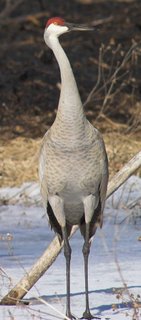 We were just about back to the parking lot, on the very short elevated path, when I spotted those loud Sandhills. They were 30-40 feet from the path, in an open area where a burn had recently been done, and they were all but posing for us. It was so wonderful to see right into their eyes from that close distance. As we were getting done watching them, we spotted another hawk of some sort, but did not ID it, nor could we find it again.
We were just about back to the parking lot, on the very short elevated path, when I spotted those loud Sandhills. They were 30-40 feet from the path, in an open area where a burn had recently been done, and they were all but posing for us. It was so wonderful to see right into their eyes from that close distance. As we were getting done watching them, we spotted another hawk of some sort, but did not ID it, nor could we find it again.
Matt had to head home to get ready for a wedding, I wanted to take a quick tour on the inside bog walk, and then I had to head home too. I didn't see those pesky to find Northern Shrikes, but I did see 30 species for the day between Prairie Crossing, Glacial Park and Volo Bog, including 4 new life birds:
#87 Ring-billed Pheasant male
#88 Sandhill Cranes
#89 Blue Jay
#90 Northern Pintails male & female
Belted Kingfisher, Common Grackle and two types of hawks
LaBagh Woods & Sauganash Prairie, Chicago, Illinois
North of Foster, east of Cicero & I94& Ronan & West River Park, Chicago Illinois
Along the Chicago River beginning at Lawrence to Argyle and north
Thursday, March 2nd, 2006, 915-1115am
My neighbor Karen was kind enough to take me out today to take a tour of her warbler route in the LaBagh Woods and Sauganash Prairie areas on Chicago's Northwest side east of I94 and north of Foster Avenue. Her experience suggests that if the warblers are seen at Montrose Beach & Harbor in the Magic Hedge, then they will also be at LaBagh, and no doubt there will be less birders, though there will be more ground to cover in one of Chicago's most unknown urban oasis.
 We parked in the east side of the park and immediately walked up to the railroad tracks. Almost as soon as we were up on them we heard and then spotted a Northern Cardinal, two American Robins, a Ring-billed Gull flyover and a COMMON GRACKLE (photo Robert Houde). Okay, it was only a Grackle, but it was a sign that the migration was beginning, and it was bird #85 and Chicago bird #43. Was never quite so happy to see a Grackle, Karen just laughed quietly at my enthusiasm.
We parked in the east side of the park and immediately walked up to the railroad tracks. Almost as soon as we were up on them we heard and then spotted a Northern Cardinal, two American Robins, a Ring-billed Gull flyover and a COMMON GRACKLE (photo Robert Houde). Okay, it was only a Grackle, but it was a sign that the migration was beginning, and it was bird #85 and Chicago bird #43. Was never quite so happy to see a Grackle, Karen just laughed quietly at my enthusiasm.
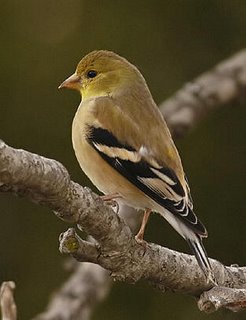 During my tour she showed me a number of great areas for warblers, pintails, teals, shorebirds. We spotted a two separate packs of Dark-eyed Juncos, and with her ear and eye, she helped me find American Goldfinches (photo Doug Greenberg) which became bird #44 for Chicago. We also had the unfortunate experience of watching a possum expire from drowning in the river. How the heck did he get himself into that fix? The answer would remain a mystery, and there was really nothing we could safely, or maybe, should have, done, to help it. Still, this just didn't feel like a good nature experience for me.
During my tour she showed me a number of great areas for warblers, pintails, teals, shorebirds. We spotted a two separate packs of Dark-eyed Juncos, and with her ear and eye, she helped me find American Goldfinches (photo Doug Greenberg) which became bird #44 for Chicago. We also had the unfortunate experience of watching a possum expire from drowning in the river. How the heck did he get himself into that fix? The answer would remain a mystery, and there was really nothing we could safely, or maybe, should have, done, to help it. Still, this just didn't feel like a good nature experience for me.
Before we got to Cicero Avenue, Karen spotted a raptor flying near the river, but we could not find it. We made our way to along the path on the north side of the river until we got to Cicero, where we crossed over the bridge and began a tour of LaBagh Woods.
We walked south to the wetland marsh area and found numerous Mallards in the now very wet marsh area. I heard a whistling bird call we were unable to locate, and though we did not find what was making this call, we did spot the resident Red-tailed Hawk perch slightly to the north of the marsh at the top of a tree. It stayed long enough for us to give it a great look, though at a distance.Once we completed our tour, Karen humored me with a quick stop at Ronan Park and West River Park to see if I could find the Belted Kingfisher reported there, as well as the Black-crowned Night Herons that were spotted there last night my MJ who posts on IBET.
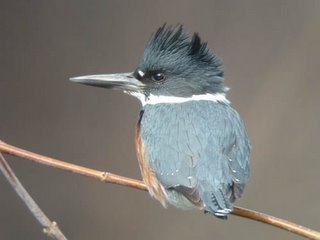 Two thirds of the way from Argyle toward Lawrence on the east river bank I spotted the BELTED KINGFISHER (photo Robert Hughes) female just as she was about to swallow a crawfish. What a treat to see this. I was spell bound with this bird. I have always had a fascination with kingfishers, this one was no different. How did I know it was a female? Unlike many birds, the female Belted Kingfisher has the color, a unique redish or rufous breast marking. Her crest was impressive and with the irregular clattering rattle she made as she flew along the river, it felt like she was the punk rocker of the Chicago birding world. She would be life bird #86 and Chicago bird #45.
Two thirds of the way from Argyle toward Lawrence on the east river bank I spotted the BELTED KINGFISHER (photo Robert Hughes) female just as she was about to swallow a crawfish. What a treat to see this. I was spell bound with this bird. I have always had a fascination with kingfishers, this one was no different. How did I know it was a female? Unlike many birds, the female Belted Kingfisher has the color, a unique redish or rufous breast marking. Her crest was impressive and with the irregular clattering rattle she made as she flew along the river, it felt like she was the punk rocker of the Chicago birding world. She would be life bird #86 and Chicago bird #45.
 As we moved north, we heard woodpeckers, saw Mallards, a Common Goldeneye, a pair of Herring Gulls in breeding plumage, a Ring-Billed flyover, and Canada Geese. But no Black-crowned Night Herons. And we really looked. Because we did, once we crossed north over Argyle into West River Park, Karen immediately spotted a juvenile Cooper's Hawk (photo Bob Lankford) on the east bank. Long tail, brownish coloring, streaked with brown on a white breast, slight white stripe over the eye. It just let us watch him. I don't think, nor do I know, that this bird would take a Goldeneye for lunch, but I did note that the last two times I had been here there were 15-20 Goldeneyes in the water, including just yesterday. But today there were only three in the river. Did they leave because of the Cooper's Hawk?
As we moved north, we heard woodpeckers, saw Mallards, a Common Goldeneye, a pair of Herring Gulls in breeding plumage, a Ring-Billed flyover, and Canada Geese. But no Black-crowned Night Herons. And we really looked. Because we did, once we crossed north over Argyle into West River Park, Karen immediately spotted a juvenile Cooper's Hawk (photo Bob Lankford) on the east bank. Long tail, brownish coloring, streaked with brown on a white breast, slight white stripe over the eye. It just let us watch him. I don't think, nor do I know, that this bird would take a Goldeneye for lunch, but I did note that the last two times I had been here there were 15-20 Goldeneyes in the water, including just yesterday. But today there were only three in the river. Did they leave because of the Cooper's Hawk?
While we were watching the Cooper, I spotted a beaver in the water four feet from where we were standing on the bank of the river. There were signs of beaver activity all along the river north of Argyle, but now he was right there for a minute or so before he dove and disappeared. Great to have such a visitor taking up residence in Chicago, gives you faith the river is cleaning itself up after all the years of neglect, BUT, he was wreaking havoc on the small trees and landscaping in this newly planted park area, AND he had begun working on a 40 foot willow on the east river bank, since yesterday, how long would the Chicago Park District put up with this "guest?" Time would tell.
Though I wanted to head back to the Wilson Street Bridge just to our south to see if I could get another look at the American Black Duck x Mallard drake hybrid I spotted there yesterday, but I had to get back to the office and get some work done. It was a good day, two new birds and one new Chicago bird, PLUS the beaver. This birding thing is getting me out to see more wildlife than I had ever noticed in my urban existence, and it put a smile on my face. For today we had found:
#85 Common Grackle#86 Belted Kingfisher female
and that Chicago River Beaver north of Argyle















